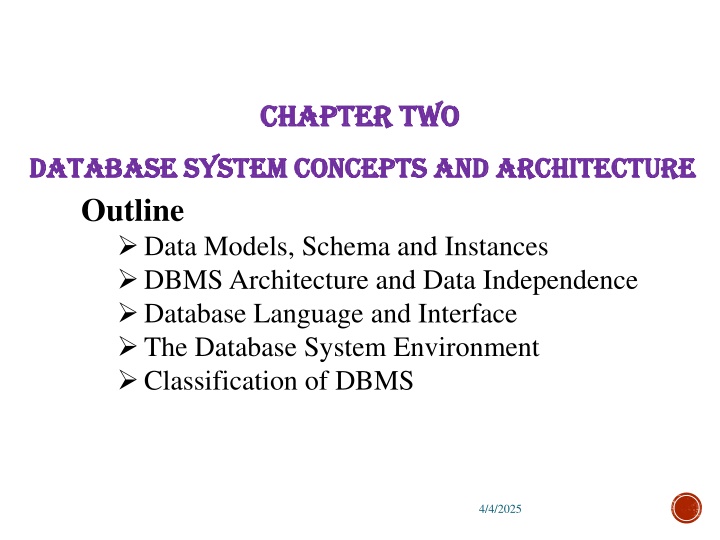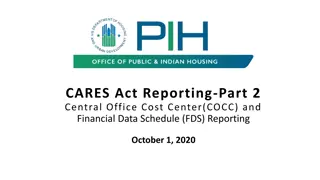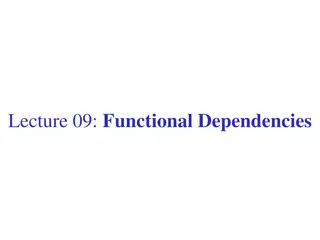
Data Models, Schema, and Instances in Database Systems
Explore the importance of data abstraction through data models, schema, and instances in the database environment. Learn about high-level and low-level data models, conceptual modeling, and representing data structures effectively for improved understanding and user interaction.
Download Presentation

Please find below an Image/Link to download the presentation.
The content on the website is provided AS IS for your information and personal use only. It may not be sold, licensed, or shared on other websites without obtaining consent from the author. If you encounter any issues during the download, it is possible that the publisher has removed the file from their server.
You are allowed to download the files provided on this website for personal or commercial use, subject to the condition that they are used lawfully. All files are the property of their respective owners.
The content on the website is provided AS IS for your information and personal use only. It may not be sold, licensed, or shared on other websites without obtaining consent from the author.
E N D
Presentation Transcript
Chapter Two Chapter Two Database System Concepts and Database System Concepts and Architecture Outline Data Models, Schema and Instances DBMS Architecture and Data Independence Database Language and Interface The Database System Environment Classification of DBMS Architecture 4/4/2025
2.1. Data Models, Schema and Instances From previous lecture; One of the main characteristics of the database approach is to support data abstraction Data abstraction: refers to hiding details of data organization and storage as well as, highlighting of the essential features for an improved understanding of data So that different users can perceive data at their preferred level of detail Data model provides the necessary means to achieve this data abstraction Data model It is a collection of concepts that can be used to describe the structure of a database (include; data types, relationships, and constraints that apply to the data).
Cont. Most data models also include a set of basic operations for specifying retrievals and updates on the database In addition to basic operations, data models include concepts to specify the dynamic aspect or behaviour of the database application (user defined operations). This allows designers to specify a set of user defined operations that are allowed on database objects Example: COMPUTE_GPA, which can be applied to a STUDENT object
Data Models, Schema and Instances contd.. Categories of Data Models: Data models can be categorized in multiple ways, according to the types of concepts that they use to describe the database structure a data models can be categorize into:- 1. High-level or conceptual data models 2. Low-level or physical data models,. 3. Representational or implementationdata models,
Categories of Data Models: 1. High-level or conceptual data models:- (common users):- provide concepts that are close to the way many users perceive/see data Use concepts such as: Entity: Represents a real-world object or concept; e.g., DEPT, COURSE Attributes: Represents some properties that further describes an entity e.g., Ccode, Cname, StId, Stname, telephone, etc. Relationships: Represents an interaction among the entities; e.g., DEPT provides COURSE
Data Models, Schema and Instances contd.. 2. Low-level or physical data models:- provide concepts that describe the details of how data is stored on the computer storage media by representing information such as:- record formats, record orderings, access path:- structure that makes the search for particular database records efficient Index:- allows direct access to data using an index term or a keyword. Concepts provided in physical data model are generally meant for computer specialists, not for end users.
Data Models, Schema and Instances contd.. 3. Representational or implementation Data Models:- this model is between the two extremes. It provide concepts that may be understood by the end user but not too far from the way data is organized computer storage. Representational data models are the models those used most frequently in traditional commercial DBMSs 4/4/2025
Data Models, Schema and Instances contd.. These include;- Relational data model and Network model Hierarchical models those have been widely used in the past. Representational data models represent data by using record structures and hence are sometimes called record-based data models. object data model also considered as an example of a new family of higher-level representational data models that are closer to conceptual data models. 8 4/4/2025
Data Models, Schema and Instances contd.. Schemas Database schema is the description of the database (not database itself) The schema is specified during database design, and Not expected to change frequently Data models have conventions for displaying schemas as a diagrams. A displayed schema is called a schema diagram(Fig 2.1) The diagram displays the structure of each record type but not the actual instances of records. Each object in the schema-such as STUDENT or COURSE-is called a schema construct. Generally, Database schema: is the description of a database Schema diagram: displays selected aspects of schema Schema construct: Each object in the schema Schema diagram represents only some aspects of a schema such as, name of record type, data element and some type of constraint see fig 2.1 9
Data Models, Schema and Instances contd.. For example, if we have a database that stores student and course information. Then the schema will be as follows STUDENT Name StudentNumber Class Major COURSE CourseName CourseNumber CreditHours Departement PREREQUISITE CourseNumber PrerequisiteNumber SECTION SectionIndentifier CourseNumber Semester Year Instructor GRADE_REPORT StudentNumber SectionIdentifier Grade fig 2.1, Schema diagram for database stores student and course information The above schema diagram shows neither the data type of each data item, nor the relationships among the various files, rather some aspects.
Data Models, Schema and Instances contd.. Instances or Database State The data in a database may change frequently, every time records are added or updated. The data in the database at a particular moment in time is called the database state or snapshot. It also called a current set of occurrences or instances in the database When we define a new database, the database state is empty state, with no data (database schema specified to the DBMS) The initial stateof the database when the database is first populated or loaded with the initial data Every time data is added/removed/updated, there is a new database state, then at any point in time, the database has a current state The DBMS is responsible for ensuring every state is a valid state; satisfies the structure and constraints specified in the schema.
2.2. DBMS Architecture and Data Independence The Three-Schema Architecture Remember from the previous chapters, three of the main characteristics of DB approach are: insulation of programs and data support of multiple user views use of a catalog to store the database description (schema). In this section we specify an architecture for database systems, called three-schema architecture, that was helps to achieve and visualize these characteristics of DB approach. The goal of the three schema architecture is to separate the user applications andthe physical database. Schema can be defined into three levels: The internal level has an internal schema Conceptual level has conceptual schema External or view level has an external schema
DBMS Architecture and Data Independence contd.. The internal level: --has an internal schema, which describes the physical storage structure of the database. uses a physical data model and describes the complete details of data storage and access paths for the database. Conceptual level has a conceptual schema, which describes the structure of the whole database for users. It hides the details of physical storage structures, and concentrates on describing entities, data types, relationships, user operations, and constraints. Use a high-level data model or an implementation data model to describe the conceptual schema. External or view level includes an external schemas or user views Each external schema describes the part of the database that a particular user group is interested in and hides the rest of the database from that user group. Represented using the representational data model.
DBMS Architecture and Data Independence contd.. The process of transforming requests and results between levels is called mapping
DBMS Architecture and Data Independence contd.. Classification of DBMSs Architecture DBMS Architecture mainly classified into two 1. Centralized DBMS Architecture 2. Client Server Architecture 1. Centralized DBMS Architecture All DBMS functionality, application program execution, and user interface processing carried out on one machine To provide these all DBMS functionalities, etc. uses mainframes User accessed systems via dumb computer terminals that only provided display capabilities, with no processing capabilities. All processing was performed remotely on the computer system, and only display information was sent to the terminals, connected via a network. Dumb terminals were replaces with workstations, which lead to the client/server architecture. 4/4/2025
DBMS Architecture and Data Independence contd.. fig 2.3, A Physical Centralized Architecture
DBMS Architecture and Data Independence contd.. 2. Client Server Architecture Define specialized servers (such as- file servers, print servers, web servers, database servers) with specific functionalities Many client machines can access resources provided by specialized server. Client machines provide user with the appropriate interfaces to utilize servers with local processing power to run local applications. Some machines are client sites, with client software installed and other machines are dedicated servers. Client machine a user machine that provides user interface capabilities and local processing. Server machine machine that provides services to client machines such as file access, printing, and database access. Client Server Architecture further categorize as: two Tier Client/Server Architecture and three Tier Client/Server Architecture
DBMS Architecture and Data Independence contd.. 2.1. Two Tier Client/Server Architecture for DBMSs The reason to call two tier architectures is that the software components are distributed over two systems, the client and server. Client side handles user interfaces and application programs. Server side handles Query and transaction functionality related to SQL processing. In this architecture, the server is called a query server or transaction server. In relational DBMSs, the server is called an SQL server, because most RDBMSs use SQL. If DMBS access is needed, the program establishes a connection to the DBMS on the server side. Once the connection is created, the client can communicate with the DBMS.
DBMS Architecture and Data Independence contd.. Two Tier Client/Server cont d Open Database Connectivity (ODBC) Provides application programming interface (API) Allows client-side programs to call the DBMS Both client and server machines must have the necessary software installed Client programs can connect to several RDBMS and send query and transaction requests using the ODBC API Query requests are sent from the client to the server, and the server processes the request and sends the result to the client. Java Database Connectivity (JDBC)
DBMS Architecture and Data Independence contd.. Two Tier Client/Server cont d fig 2.4. Logical two Tier Client/Server Architecture fig 2.5. Physical two Tier Client/Server Architecture
DBMS Architecture and Data Independence contd.. 2.2. Three-Tier Client/Server Architecture for Web Applications Many web applications use three-tier architecture, which adds an intermediate layer between the client and the database server. The middle tier is called the application server, or the web server. It Plays an intermediate role, by storing business rules (procedures/constraints) used to access data from database. It Can improve database security by checking the clients credentials before forwarding request to database server. Clients contain GUI interfaces and application specific rules. The intermediate server accepts the requests from the client, processes the request and sends the database commands to the db server, Then passes the data from the database server to the client, where it may be processes further and filtered. The three tiers are: user interface, application rules, and data access.
DBMS Architecture and Data Independence contd.. Three Tier Client/Server cont d fig 2.6. Logical Three Tier Client/Server Architecture
DBMS Architecture and Data Independence contd.. Data Independence The three schema architecture further explains the concept of data independence. Data independence:- is the capacity to change the schema at one level of a database system without having to change the schema at the next higher level. Only the mapping between the levels is changed. There are two types of data independence: 1. Logical data independence: is the ability to change the conceptual schema without having to change external schemas or application programs. When data is added or removed, only the view definition and the mappings need to be changed in the DBMS that support logical data independence. If the conceptual schema undergoes a logical reorganization, application programs that reference the external schema constructs must work as before.
DBMS Architecture and Data Independence contd.. 2. Physical data independence:- is the ability to change the internal schema without having to change the conceptual/external schemas. By extension, the external schema should not change as well. Physical file reorganization to improve performance (such as creating access structures) results in a change to the internal schema. If the same data as before remains in the database, the conceptual schema should not change. For example, providing an access path to improve retrieval speed of section records by semester and year should not require a query to be changed, although it should become more efficient by utilizing the access path With a multi-level DBMS, the catalogue must be expanded to include information on how to map requests and data among the levels. The DBMS uses additional software to accomplish the mappings.
2.3. Database Language and Interface As we discussed previously, database supports a number of user groups. Therefore, the DBMS must have languages and interfaces that support each user group DBMS Languages Data Definition Language (DDL) Storage Definition Language (SDL) View Definition Language (VDL) Data Manipulation Language (DML) DDL: used by the DBA and database designers to define the conceptual and internal schemas for the database and any mappings between the two. The DBMS has a DDL compiler to process DDL statements in order to identify the schema constructs, and to store the description in the catalogue SDL: used when clear distinction between conceptual and internal schema. Specifies the internal schema
Database Language and Interface contd.. In databases where there is a separation between the conceptual and internal schemas, DDL is used to specify the conceptual schema, and SDL, is used to specify the internal schema. VDL: is used to specify the user views and their mappings to the conceptual schema. But in most DBMSs, the DDL is used to specify both the conceptual schema and the external schemas. Once the schemas are compiled and the database is populated with data, users need to manipulate the database. Manipulation includes the operations such as retrieval, insertion, deletion and modification. DML: allows retrieval, insertion, deletion, and modification of the data There are two main types of DMLs: High-level or nonprocedural DML & Low-level or procedural DML
Database Language and Interface contd.. High-level or nonprocedural DML: Can be used on its own to specify complex database operations briefly DMBSs allow DML statements to be entered interactively from a terminal, or to be embedded in a programming language. Example of high-level DMLs is SQL, which can retrieve many records in a single DML statement, and are called set at a time or set oriented DMLs. Low-level or procedural DML Must be embedded in a general-purpose programming language Typically retrieves individual records or objects from the database and processes each separately. Therefore it needs to use programming language constructs such as loops. because of this, Low-level DMLs are also called record at a time DMLS.
Database Language and Interface contd.. DML often specifies what to retrieve, rather than how to retrieve it. Due to this high-level languages are often called declarative. DML Commands Since DML commands are embedded in a general purpose programming language, then the programming language is called the host language and the DML is called the data sub-language. High-level languages used in a standalone and interactive manner are called a query language. Casual end users use high-level query language to specify requests, where programmers usually use embedded DML. Parametric and casual end users, who don t want to learn the high-level languages usually interact with user-friendly interfaces. In most DBMSs, the VDL, DDL & DML are not considered separate languages, but a comprehensive integrated language. An example of a comprehensive language is SQL, which represents a combination of VDL, DDL, DML, as well as statements for constraint specification and schema evolution
Database Language and Interface contd.. DBMS Interfaces Types of interfaces provided by the DBMS include: Menu-Based Interfaces for Web Clients or Browsing Present users with list of options (menus) Lead user through formulation of request Query is composed of selection options from menu displayed by system. Forms-Based Interfaces Displays a form to each user (insert, select). User can fill out form to insert new data or fill out only certain entries. Designed and programmed for na ve users as interfaces to canned transactions. Graphical User Interfaces Displays a schema to the user in diagram form. The user can specify a query by manipulating the diagram. GUIs use both forms and menus.
Database Language and Interface contd.. Natural Language Interfaces Accept requests in written English or other native languages and attempt to understand them. Interface has its own schema and a dictionary of important words. Uses the schema and dictionary to interpret a natural language request. Interfaces for Parametric Users Parametric users have small set of operations they perform. Analysts and programmers design and implement a special interface for each class of na ve users. Often a small set of commands included to minimize the number of keystrokes required (i.e. use of function keys) Interfaces for the DBA Systems contain privileged commands only for DBA staff. Include commands for creating accounts, setting parameters, authorizing accounts, changing the schema, reorganizing the storage structures etc.
2.4. The Database System Environment DBMS Environment Component Modules Stored data manager The database and the database catalogue are stored on disk Access to the disk is handled by the Operating System. A higher-level stored data manager controls access to DBMS information that is stored on disk, whether part of the database or the catalogue. The stored data manager may use basic OS services for carrying out low-level data transfer, such as handling buffers. Once data is in buffers, the other DBMS modules, as well as other application programs can process it. Runtime Database Processor Handles database access at runtime. Received retrieval or update operations and carries them out on the database. Access to the disk goes through the stored data manager.
Database System Environment contd.. DDL compiler Processes the schema definitions and stores the descriptions (meta- data) in the catalogue. Query Compiler Handles high-level queries entered interactively. Parses, analyzes and interprets a query, then generates calls to the runtime processor for execution. Precompiler Extracts DML commands from an application program written in a host language. Commands are sent to DML compiler for compilation into code for database access. The rest is sent to the host language compiler. Client Program Accesses the DBMS running on a separate computer from the computer on which the database resides. It is called the client computer, and the other is the database server. In some cases a middle level is called the application server.
Database System Environment contd.. fig 2.7. Typical component modules of a DBMS, The dotted lines indicate an accesses that are under the control of the stored data manager
2.5. Classification of DBMSs According to Data Model Classification by focusing on the structure of data organizing i. Relational data model ii. Object data model iii. Hierarchical data model: data are organized into a tree-like structure & use parent/child iv. Network data model v. Object relational data model According to Number of Users supported by the system i. Single User systems ii. Multi User systems According to Number of Sites over which the database is distributed i. Centralized data is stored at single site. ii. Distributed database and DBMS software stored over many sites connected by network a. Homogeneous use same DBMS software at multiple sites. b. Federated DBMSs- access preexisting databases stored under heterogeneous DBMSs According to Cost i. Low-end systems under $3000 ii. High-end systems, over $100,000
READING ASSIGNMENT FOR ADDITIONAL KNWLEDGE Database System Utilities DBMSs have database utilities that help the DBA manage the system Loading: load existing files into the DB Backup: creates backup copy of the DB File reorganization: reorganize files for better performance Performance monitoring: monitor DB usage and provide statistics to DBA Tools, Application Environments & Communications Facilities CASE tools: Used in design phase Data (information) dictionary system: store catalog info, design decisions, usage, app program description, user information Application development environments: e.g. Jbuilder- help in development of DB design, GUI, query, update etc. Communication Software: allow users remotely to access the DB



